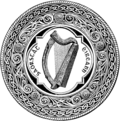| Governor-General of the Irish Free State Seanascal Shaorstát Éireann | |
|---|---|
 | |
| Style | His Excellency |
| Residence | Viceregal Lodge |
| Appointer | Monarch of the Irish Free State:
|
| Precursor | Lord Lieutenant of Ireland |
| Formation | 6 December 1922 |
| First holder | Tim Healy |
| Final holder | Domhnall Ua Buachalla |
| Abolished | 11 December 1936 |
| Succession | Executive Council of the Irish Free State[1] |
The governor-general of the Irish Free State (Irish: Seanascal Shaorstát Éireann) was the official representative of the sovereign of the Irish Free State from 1922 to 1936. By convention, the office was largely ceremonial. Nonetheless, it was controversial, as many Irish Nationalists regarded the existence of the office as offensive to republican principles and a symbol of continued British involvement in Irish affairs, despite the Governor-General having no connection to the British Government after 1931. For this reason, the office's role was diminished over time by the Irish Government.
The 1931 enactment in London of the Statute of Westminster gave the Irish Free State full legislative independence. However, the Irish considered that full legislative independence had been achieved in 1922. The role of governor-general in the Irish Free State was removed from the Constitution on 11 December 1936,[2] at the time of Edward VIII's abdication as king of the United Kingdom and all the Dominions.
- ^ Constitution (Amendment No. 27) Act 1936 — The office was abolished before the current Irish constitution providing for a president came into force.
- ^ "The Republic of Ireland Bill 1948—Second Stage – Seanad Éireann (6th Seanad) – Thursday, 9 December 1948". Oireachtas. Archived from the original on 26 January 2019. Retrieved 30 March 2020.